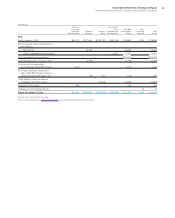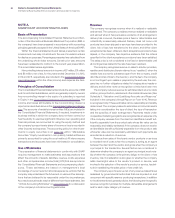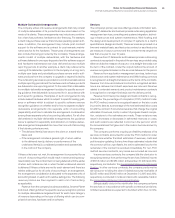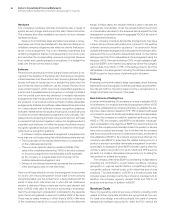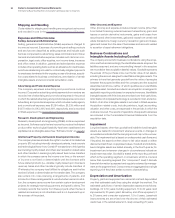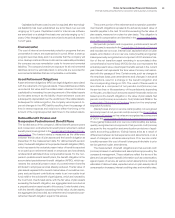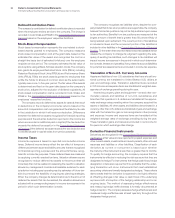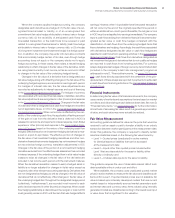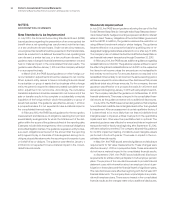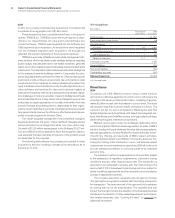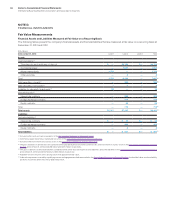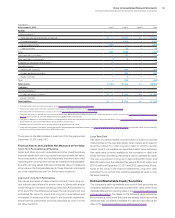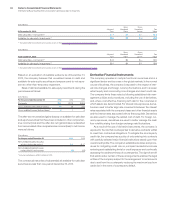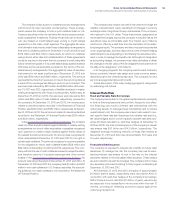IBM 2013 Annual Report Download - page 94
Download and view the complete annual report
Please find page 94 of the 2013 IBM annual report below. You can navigate through the pages in the report by either clicking on the pages listed below, or by using the keyword search tool below to find specific information within the annual report.Notes to Consolidated Financial Statements
International Business Machines Corporation and Subsidiary Companies
93
Financing Receivables
Financing receivables include sales-type leases, direct financing
leases and loans. Leases are accounted for in accordance with
lease accounting standards. Loan receivables are financial assets
recorded at amortized cost which approximates fair value. The com-
pany determines its allowances for credit losses on financing
receivables based on two portfolio segments: lease receivables and
loan receivables. The company further segments the portfolio into
two classes: major markets and growth markets.
When calculating the allowances, the company considers its abil-
ity to mitigate a potential loss by repossessing leased equipment and
by considering the current fair market value of any other collateral.
The value of the equipment is the net realizable value. The allowance
for credit losses for capital leases, installment sales and customer
loans includes an assessment of the entire balance of the capital
lease or loan, including amounts not yet due. The methodologies
that the company uses to calculate its receivables reserves, which
are applied consistently to its different portfolios, are as follows:
Individually Evaluated—
The company reviews all financing receiv-
ables considered at risk on a quarterly basis. The review primarily
consists of an analysis based upon current information available
about the client, such as financial statements, news reports, pub-
lished credit ratings, current market-implied credit analysis, as well
as the current economic environment, collateral net of repossession
cost and prior collection history. For loans that are collateral depen-
dent, impairment is measured using the fair value of the collateral
when foreclosure is probable. Using this information, the company
determines the expected cash flow for the receivable and calculates
an estimate of the potential loss and the probability of loss. For
those accounts in which the loss is probable, the company records
a specific reserve.
Collectively Evaluated—The company records an unallocated
reserve that is calculated by applying a reserve rate to its different
portfolios, excluding accounts that have been specifically reserved.
This reserve rate is based upon credit rating, probability of default,
term, characteristics (lease/loan) and loss history. Factors that could
result in actual receivable losses that are materially different from
the estimated reserve include sharp changes in the economy, or a
significant change in the economic health of a particular client that
represents a concentration in the company’s receivables portfolio.
Other Credit-Related Policies
Non-Accrual—Certain receivables for which the company has
recorded a specific reserve may also be placed on non-accrual
status. Non-accrual assets are those receivables (impaired loans or
nonperforming leases) with specific reserves and other accounts
for which it is likely that the company will be unable to collect all
amounts due according to original terms of the lease or loan agree-
ment. Income recognition is discontinued on these receivables. Cash
collections are first applied as a reduction to principal outstanding.
Any cash received in excess of principal payments outstanding is
recognized as interest income. Receivables may be removed from
non-accrual status, if appropriate, based upon changes in client
circumstances.
Write Off—Receivable losses are charged against the allowance
when management believes the uncollectibility of the receivable
is confirmed. Subsequent recoveries, if any, are credited to the
allowance.
Past Due—The company views receivables as past due when
payment has not been received after 90 days, measured from the
original billing date.
Impaired Loans—As stated above, the company evaluates all financ-
ing receivables considered at-risk, including loans, for impairment
on a quarterly basis. The company considers any loan with an indi-
vidually evaluated reserve as an impaired loan. Depending on the
level of impairment, loans will also be placed on non-accrual status
as appropriate. Client loans are primarily for software and services
and are unsecured. These loans are subjected to credit analysis to
evaluate the associated risk and, when deemed necessary, actions
are taken to mitigate risks in the loan agreements which include
covenants to protect against credit deterioration during the life of
the obligation.
Estimated Residual Values of Lease Assets
The recorded residual values of lease assets are estimated at the
inception of the lease to be the expected fair value of the assets at
the end of the lease term. The company periodically reassesses the
realizable value of its lease residual values. Any anticipated increases
in specific future residual values are not recognized before realiza-
tion through remarketing efforts. Anticipated decreases in specific
future residual values that are considered to be other than temporary
are recognized immediately upon identification and are recorded as
an adjustment to the residual value estimate. For sales-type and
direct-financing leases, this reduction lowers the recorded net
investment and is recognized as a loss charged to financing income
in the period in which the estimate is changed, as well as an adjust-
ment to unearned income to reduce future-period financing income.
Common Stock
Common stock refers to the $.20 par value per share capital stock
as designated in the company’s Certificate of Incorporation. Trea-
sury stock is accounted for using the cost method. When treasury
stock is reissued, the value is computed and recorded using a
weighted-average basis.
Earnings Per Share of Common Stock
Earnings per share (EPS) is computed using the two-class method.
The two-class method determines EPS for each class of common
stock and participating securities according to dividends and dividend
equivalents and their respective participation rights in undistributed
earnings. Basic EPS of common stock is computed by dividing net
income by the weighted-average number of common shares out-
standing for the period. Diluted EPS of common stock is computed
on the basis of the weighted-average number of shares of common
stock plus the effect of dilutive potential common shares outstanding
during the period using the treasury stock method. Dilutive potential
common shares include outstanding stock options, stock awards and
convertible notes.


